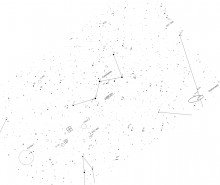This time we’re taking a look at the constellation of Cassiopeia. To the ancient Greeks, she was a mythical queen; wife of King Cepheus and mother of Andromeda. To be honest, it’s hard to see how a large ‘W’ could be imagined as a beautiful queen, but there’s no doubt that Cassiopeia is one of the most readily identifiable and beautiful of constellations.
Visible all year round from the UK, Cassiopeia is currently high in the north-east, the five stars that comprise it clearly marking out a large ‘W’ (tipped up to the left). There are a number of beautiful binocular- and telescope-visible objects in and around Cassiopeia, and it’s a good place to start when you’re learning your way around the night sky.
Beginning with the middle star of the ‘W’ (Gamma Cassiopeia, also known as Navi), scan down through the lower left star (Ruchbah) and on about twice as far again. You’ll come across one of the most beautiful sights in the night sky: the Double Cluster in Perseus (NGC 884 & 869). Often visible to the naked eye as a faint smudge, a pair of binoculars or small telescope will really show this off. It’s been described as seeing two handfuls of diamonds scattered on black velvet, and they are truly spectacular.
Again beginning at Gamma Cassiopeia but this time scanning through the lower right star of the ‘W’ (Shedir) will bring you to the Andromeda galaxy (M31). Also faintly visible to the naked eye, a pair of binoculars will show off the stretched oval shape of the bright central portion of our nearest galactic neighbour. On a really clear night you may be able to make out the main dark dust ring around the galaxy, and maybe even its two satellite galaxies, M32 and M110.
To the left of Ruchbah is M103, a fairly large and sparkly open cluster of about 40 stars (including a couple of red giants). To the right is one of my favourite observing targets: the Dragonfly (or Owl) cluster (NGC 457). This really is very nice, the two brightest stars of the cluster appearing like sparkly owl’s eyes, with the rest of the cluster forming the body and outstretched wings. NGC 457 contains about 150 stars in total.
From Shedir, scan upward through the upper right star (Caph) and on again for just over the same distance and you’ll find M52, another large and bright open cluster containing approximately 190 stars.
Scanning down from the extreme left-hand star (Epsilon Cassiopeia) parallel to the line that took you to the Perseus Double cluster will take you to the Heart and Soul nebulae (IC 1805 & 1848). On a clear night, and using a pair of reasonable binoculars or a small telescope, these large clouds should be fairly obvious. These are star forming nebulae, and you should be able to make out a number of small open star clusters in the region.
Although actually in Camelopardalis, Kemble’s Cascade is well worth a visit while you’re in the area. Binoculars will show this as a curving arc of stars, filling the field of view, and ending in the dense star cluster NGC 1502. To find it, scan down from Epsilon Cassiopeia, passing to the left of the Heart and Soul nebulae and going about the same distance again. It may take you a few attempts to find it, but it’s well worth the effort.
Once you become familiar with Cassiopeia I guarantee you’ll return again and again, and, like me, you may also use the constellation as your starting point when exploring the neighbouring constellations of Perseus, Andromeda, Camelopardalis and Cepheus. The Milky Way also runs through Cassiopeia, and the constellation provides a good jumping off point when observing its star clouds, nebulae and clusters.
What’s up
The brief mention of Kemble’s Cascade above brought to mind another of my favourite asterisms (an asterism is a group of stars, usually smaller than a constellation but more loose than a cluster, the shape of which is often suggestive of some familiar object). The ten stars of the ‘Coat-hanger’ asterism (also known as Brocchi’s cluster) are high overhead at this time of year, just ahead of and below the foremost star of Cygnus (Alberio). Its exact location is quite hard to describe in words, but a quick search on Google will give you its position; it’s fairly easy to find and is well worth checking out.
Clear skies!
Kevin Quinn is an amateur astronomer based in Cerne Abbas, he is the proud owner of a ten-inch reflector and a hefty pair of binoculars. He tweets via @CerneAstro, blogs via theastroguy.wordpress.com, and his ebook ‘Demystifying Astronomy – A beginner’s guide to telescopes, eyepieces and accessories for visual astronomy’ is widely available.
©Kevin Quinn












